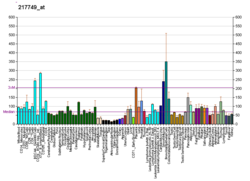
COPI is a coatomer, a protein complex that coats vesicles transporting proteins from the cis end of the Golgi complex back to the rough endoplasmic reticulum (ER), where they were originally synthesized, and between Golgi compartments. This type of transport is retrograde transport, in contrast to the anterograde transport associated with the COPII protein. The name "COPI" refers to the specific coat protein complex that initiates the budding process on the cis-Golgi membrane. The coat consists of large protein subcomplexes that are made of seven different protein subunits, namely α, β, β', γ, δ, ε and ζ.

ADP-ribosylation factor 6 (ARF6) is a member of the ADP ribosylation factor family of GTP-binding proteins. ARF6 has a variety of cellular functions that are frequently involved in trafficking of biological membranes and transmembrane protein cargo. ARF6 has specifically been implicated in endocytosis of plasma membrane proteins and also, to a lesser extent, plasma membrane protein recycling.
The coatomer is a protein complex that coats membrane-bound transport vesicles. Two types of coatomers are known:

ADP-ribosylation factor 1 is a protein that in humans is encoded by the ARF1 gene.

ADP-ribosylation factor-binding protein GGA1 is a protein that in humans is encoded by the GGA1 gene.

Coatomer subunit beta is a protein that in humans is encoded by the COPB1 gene.

ADP-ribosylation factor 3 is a protein that in humans is encoded by the ARF3 gene.

Coatomer subunit alpha is a protein that in humans is encoded by the COPA gene.

Coatomer subunit epsilon is a protein that in humans is encoded by the COPE gene.

Golgi-specific brefeldin A-resistance guanine nucleotide exchange factor 1 is a protein that in humans is encoded by the GBF1 gene.

Coatomer subunit beta is a protein that is encoded by the COPB2 gene in humans.

Coatomer subunit gamma-2 is a protein that in humans is encoded by the COPG2 gene.

Golgin subfamily A member 4 is a protein that in humans is encoded by the GOLGA4 gene.

ADP-ribosylation factor 5 is a protein that in humans is encoded by the ARF5 gene.

ADP-ribosylation factor 4 is a protein that in humans is encoded by the ARF4 gene.

AP-1 complex subunit gamma-like 2 is a protein that in humans is encoded by the AP1G2 gene.

Arf-GAP with SH3 domain, ANK repeat and PH domain-containing protein 2 is a protein that in humans is encoded by the ASAP2 gene.

Golgin subfamily A member 5 is a protein that in humans is encoded by the GOLGA5 gene.

Coatomer subunit zeta-1 is a protein that in humans is encoded by the COPZ1 gene.

Giantin or Golgin subfamily B member 1 is a protein that in humans is encoded by the GOLGB1 gene. Giantin is located at the cis-medial rims of the Golgi apparatus and is part of the Golgi matrix that is responsible for membrane trafficking in secretory pathway of proteins. This function is key for proper localisation of proteins at the plasma membrane and outside the cell which is important for cell function that is dependent on for example receptors and the extracellular matrix function. Recent animal model knockout studies of GOLGB1 in mice, rat, and zebrafish have shown that phenotypes are different between species ranging from mild to severe craniofacial defects in the rodent models to just minor size defects in zebrafish. However, in adult zebrafish a tumoral calcinosis-like phenotype was observed, and in humans such phenotype has been linked to defective glycosyltransferase function.
























